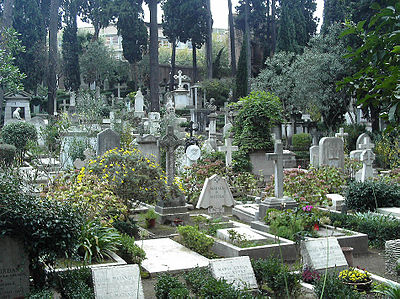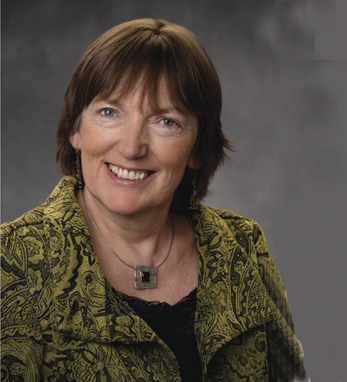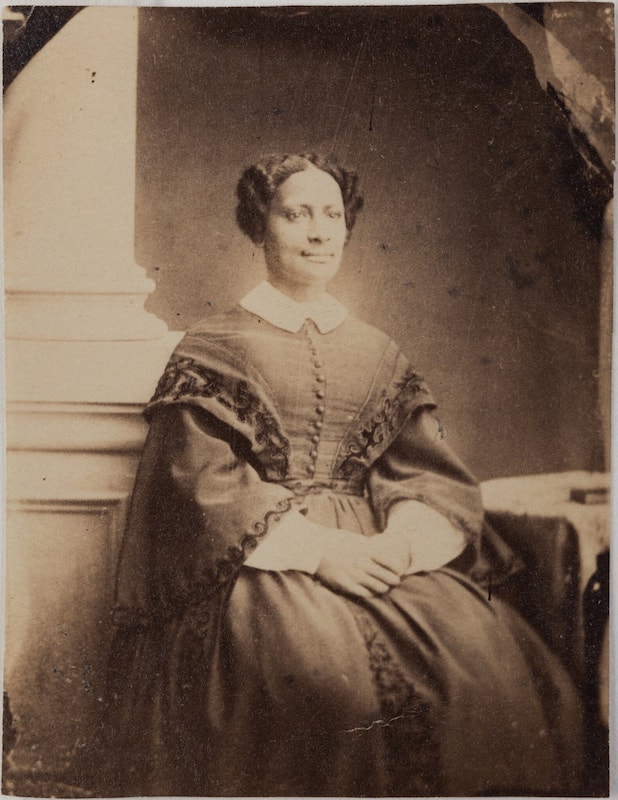Continuing Christine Kinealy’s series on Black abolitionists who visited Ireland, we find, in Sarah Parker Remond, a woman who was remarkable and fearless.
Frederick Douglass’s visit to Ireland 175 years ago—an experience that he described as “transformative”—has been commemorated on both sides of the Atlantic. However, Frederick was not the first or the last black abolitionist to spend time in the country, although he is the most celebrated. On 29 December 1858, Sarah Parker Remond sailed from Boston to Liverpool. Following a short stay in the north of England, Sarah traveled to Dublin, to lecture on abolition. Her gender not only marked her as an unusual spokesperson for abolition, but also her family connections. Sarah was the sister of Charles Lenox Remond who had lectured in Britain and Ireland in 1840 and 1841. During this time, he had spoken alongside Daniel O’Connell, then the leading figure in transatlantic abolition. But while Sarah was following in the footsteps of her brother, Charles, and of their friend, Frederick Douglass, she created a niche within the abolition movement that marked her out as being both remarkable and fearless. Who was Sarah?
Sarah Parker Remond was born in Salem, Massachusetts, in 1826 to John and Nancy (neé Lenox) Remond, two free-born blacks. She was the second youngest of ten children and 16 years younger than her brother, Charles. As a free black person, Sarah was able to learn to read and write. Yet, despite her family being prosperous, because of her colour, she received limited schooling, later admitting, “My strongest desire through life has been to be educated.” Sarah’s tenacity and willingness to challenge authority became evident in 1853 when she was refused a ticket and ejected from a public theatre in Boston, on the grounds of her colour. During the process, she had been pushed down the stairs. Sarah took the matter to the press and to the police. The theatre was fined and made to pay the legal costs.
Before traveling to England, Sarah was known on the New England abolition circuit, working as a lecturer for William Lloyd Garrison’s American Anti-Slavery Society. She and her brother were also supporters of women’s suffrage, both speaking at a Woman’s Rights Convention in New York City in 1858. Although associated with Garrison, Sarah travelled to the United Kingdom as an independent abolitionist, who was not affiliated to any society. In relation to a suggestion that she should contact the people who had welcomed her brother almost 20 years earlier, she wrote, “It is a long time since he visited England, so I shall gather up all my courage, and endeavour to depend on myself.” She described her motivations for leaving America were “that I might for a time enjoy freedom and serve the anti-slavery cause at the same time.” At this stage, Sarah intended to remain oversees for 12 months.
Sarah gave her first lecture on British soil in Liverpool. Shortly afterwards, despite being ill, she spoke to an audience of women only in the nearby town of Warrington. The women presented her with a watch inscribed, “To S.P. Remond by Englishwomen, her sisters, in Warrington. February 2nd, 1850.” Sarah responded to this gesture by saying that a testimonial was unnecessary as, since being in England, “I have been removed from the degradation which overhangs all persons of my complexion …. I have received a sympathy I was never offered before.”
Shortly afterwards, Sarah sailed to Ireland. In Dublin, just as Charles, Frederick and many other abolitionists had done, she stayed at the home of Richard and Hannah Webb, Quaker abolitionists. Richard was delighted with his latest visitor, writing:
She is very clever—the most so of all the coloured people I ever met, except Douglass, and is a much more sensible and thoroughgoing person than he. Except Wendell Phillips, I don’t think you could have a more effective agent here. She is far less crotchety than Wright or Pillsbury. She has more common sense—and her devotion to the cause and its friends is thorough. We like her very much.
Sarah’s first lecture was in the Rotundo Rooms on 11 March. She was there at the invitation of the Dublin Ladies’ Anti-Slavery Society. Admission was free. The Lord Mayor of Dublin was unable to attend in person but sent a letter of support. When Sarah stood up to speak, she was “hailed with long and repeated plaudits.” She was also praised in the local press, the Freeman’s Journal describing her appearance as “remarkably feminine and graceful, coupled with a quiet, dignified manner, a well-toned voice and pleasing style of enunciation.” Sarah’s gentle demeanour was matched by her uncompromising denunciation of slavery and all who upheld it. She described the daily “odium, obloquy and hatred” directed at those who spoke on behalf of enslaved people. Controversially, she included several Christian Churches in this criticism. Sarah concluded by addressing a topic that she would make her own distinctive contribution to anti-slavery, namely the treatment of women slaves—a topic rarely addressed directly by male abolitionists. She appealed directly to the women in the audience:
… on behalf of the female slave, the most deplorably and helplessly wretched of human sufferers. Of all who dropped and writhed under the infliction of this horrible system, the greatest sufferer was defenceless women (hear!) For the male slave, however brutally treated, there was some resources: but for the woman slave, there was neither protection nor pity.
It was a triumphant and accomplished performance, reminiscent of the appearances of Frederick Douglass two decades earlier. It was praised by all who heard it, including the Rev. Dr. Foley, Professor of Irish in Trinity College, who said that “his heart had been stirred within him by the language and sentiments of the splendid address they had heard from the lips of Miss Remond.”
Sarah gave two more lectures in Dublin, which were equally well received. Her topics included the Underground Railroad and the Fugitive Slave Act, but the treatment of enslaved women was always part of her forceful message. Unusually for such visitors, Sarah also talked about Irish history and politics, describing the poverty and degradation of the poor in Ireland “with painful precision.” Sarah then travelled south, where she stayed for almost a month, lecturing three times in Waterford, once in Clonmel, and twice in Cork. In each location, she was received “with respect and cordial hospitality.” Again, the press provided extensive and favourable coverage, the Waterford Mail reporting:
Miss Remond, a coloured lady, who is traveling in this country, delivered a very interesting lecture on American Slavery in the Large Room, Town Hall, on Tuesday Evening. The Chair was taken by Dr. Elliott, who introduced her to the meeting with an appropriate address. Miss Remond is an excellent female lecturer, one of the best we have heard. Her manner is gentle, yet impressive; her countenance intelligent and animated, her language pure; her diction copious, and her thoughts elevated.
Sarah’s time in Ireland coincided with the arrival of six political refugees from the Italian states, known as the Neapolitan exiles, who were seeking the unification and independence of Italy. Their meeting sparked Sarah’s life-long interest in Italy and Italian politics.
Sarah returned to England in the summer of 1859, where she continued to lecture. Later in the year, she was joined by Frederick Douglass, he having left America peremptorily to avoid arrest following John Brown’s unsuccessful insurrection. The two friends lectured on a number of occasions together although, tellingly, Frederick always received the top billing. During this period, Sarah made a decision not to return to the United States. Instead, she realized her long-term ambition to receive further education, and enrolled as a student at the Ladies’ College in Bedford Square, London. Despite her studies, Sarah continued to be a presence in the transatlantic abolitionist movement. In November 1860, as America descended towards a civil war, she was one of a group of powerful women abolitionists who called for a peaceful ending to slavery:
We earnestly and cordially entreat all who love our native land in sincerity, whether Europeans or Americans, to unite with us more numerously and more generously than ever, to meet the demands of a period of crisis unparalleled in the history of our country new, indeed, in the history of the world. For when before has it ever happened that freedom has been sought from among dominant people for down-trodden one, on so grand a scale this?
Even when the war was over, and slavery had been ended, Sarah chose not to return to the United States. In 1866, she moved to Florence in Italy to study medicine, qualifying as a physician. Even from a distance though, she was a critic of Post-War Reconstruction and the prejudice that accompanied it. In 1877, Sarah, now aged 50, married an Italian man, Lazzaro Pintor. Ten years later, Frederick Douglass and his second wife, Helen, who were undertaking a year-long tour of Europe, visited Sarah and Lazzaro and two of Sarah’s sisters, who were now all residing in Rome. Following this, Frederick wrote that the Remond sisters, “detest prejudice of color and say they would not live in the United States if you would or could give them America.” Sarah never returned to the United States, but died in Rome in 1894, where she was buried.

Photo: Public domain.
Sarah’s time in Ireland was short, but significant. She chose Ireland, which had so warmly welcomed her brother almost two decades earlier, to spend her early months overseas. There, she lectured in four very different locations and there, she honed her skills as a transatlantic lecturer and as a champion of enslaved women. In Ireland also, as both her brother and Frederick Douglass had done some years earlier, she came to understand what freedom and equality meant. Although Sarah’s time in Ireland is largely forgotten today, her presence in the country on the eve of the American Civil War, kept the flame of anti-slavery burning brightly, especially amongst women. By creating a feminist abolitionist agenda, she united the “woman’s question” and abolition together in a way that her male compatriots could not. In this way, Sarah carved out a pathway that was uniquely her own amongst abolitionists, and she made a contribution to transatlantic anti-slavery that was both extraordinary and invaluable.
 Dr. Christine Kinealy is the author of “Black Abolitionists in Ireland” (Routledge, 2020). The book examines ten abolitionists – nine men and one woman – who visited Ireland between 1791 and 1860.
Dr. Christine Kinealy is the author of “Black Abolitionists in Ireland” (Routledge, 2020). The book examines ten abolitionists – nine men and one woman – who visited Ireland between 1791 and 1860.
Christine is the Director of Ireland’s Great Hunger Institute at Quinnipiac University, and is the author of many books and articles on famines in Ireland.


Any chance her experience in Ireland led to the inclusion of the women’s right to vote in Ireland?
Significantly informative. Thank you!
Sarah Parker Redmond and her siblings were extraordinary ancestors of our family lineage.
Dr. Sheila Redmond
How wonderful to be descended from this brilliant woman. I am currently writing about her, and three other African-Americans who came to Britain in the 1850s to seek British support for abolition of slavery–as well as education and refuge. I am wondering where the name Parker came from? Also, are there any of her letters available?